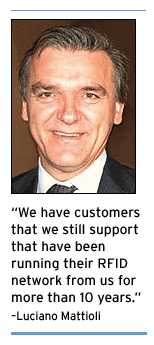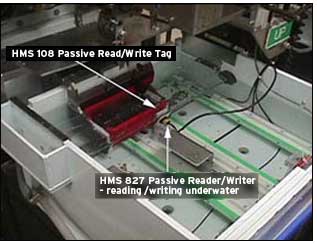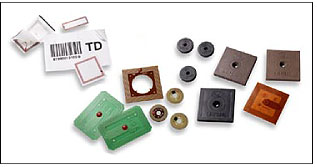Jun 14, 2004The promise of a single global RFID standard operating in UHF based on the Electronic Product Code (EPC) standards has created a whirl of excitement about RFID’s potential. But some companies have long been designing, deploying and supporting specialized non-EPC RFID systems for their customers.
One such company is Escort Memory Systems (EMS), in Scotts Valley, Calif. Founded in 1985, EMS has built a business around designing specialized tags and readers and deploying them in manufacturing plants and industrial operations.
“We have customers that we still support that have been running their RFID network from us for more than 10 years,” says Luciano Mattioli, president and CEO of EMS. “We design and support closed-loop systems that are used over and over again.”
The company supports even older systems: those deployed by control and engineered-services company Allen-Bradley, which is now owned by Rockwell Automation. In 1999, Rockwell Automation named Escort Memory Systems as one of its preferred global RFID technology suppliers to Allen-Bradley customers, after the company decided it would no longer manufacture RFID equipment. Mercedes-Benz’s transmission factory in Mettingen, Germany, and MEMC Electronic Materials’ wafer fabrication plant in Sherman, Texas, both use a combination of Allen-Bradley and EMS products.
“EMS is without a doubt the market leader in HF [high-frequency] readers,” says Erik Michielsen, senior analyst at ABI, a technology market research firm based in Oyster Bay, N.Y. “EMS has experience with some of the biggest companies that have deployed RFID.” Its impressive list of customers include Johnson Controls, Seagate Technology, Procter & Gamble and Gillette, as well as such automakers as Ford, Toyota, Mercedes and General Motors.
While RFID readers have been the focus of EMS’s business, the company also offers a range of specialized tags, software and support services. EMS developed tags for the automotive industry that could withstand the heat of paint ovens, where temperatures can exceed 200 degrees C. The company also worked with Swedish pallet manufacturer Arca Systems and the Italian Post to develop the world's first RFID post office application. It involved embedding an RFID tag permanently inside a pallet. And EMS has worked on projects that called for embedding RFID labels inside skiing/snowboarding equipment and even into wooden doors.
EMS has a variety of high-frequency (13.56 MHz) and low-frequency (400 kHz) systems. Its FastTrack line of RFID tags, labels, printed circuit boards and reader-writers includes specialized tags that can endure high temperatures or other harsh environmental conditions. Its HMS-Series third-generation passive read-write system includes tags, handheld reader-writers, antennas and ancillary equipment, including submersible antenna designs developed for the disc drive industry.
EMS says it is now targeting some key markets with its 13.56 MHz HF closed-loop systems. “RFID for manufacturing is a major, strong market,” says Mattioli. “We are also developing systems for the transportation and logistics market.”
EMS’s focus on closed-loop RFID systems is justified, say analysts, because such systems represent a simpler and more straightforward investment for RFID customers; networks can be designed and deployed to address specific and possibly unique operational criteria without having to conform to a technology that is shared between any number of other companies in the supply chain. In addition, because tags are often reused for many years, the cost of the tag is less of an issue than tags used once in the supply chain.
“There is a solid business in high-frequency RFID, and there remains a lot of high-growth applications for closed-loop high-frequency systems,” says Mike Liard, senior AIDC/RFID analyst at Venture Development Corp. (VDC), a Natick, Mass.-provider of market research and consulting services to technology companies. “Closed-loop HF systems are a whole different value proposition than UHF,” he says. “They are less complex, have already proven themselves, have effective returns on investment that can be shown [to potential customers] and have an established ISO technology standard.”
Those factors are now set to push the HF market through a period of significant growth. In 2003, high-frequency tag sales reached $83.2 million. By the end of 2007, sales should grow to $493 million, according to research by VDC.
While seeing plenty of potential in UHF systems, EMS is confident that its existing HF business will remain its focus. When it comes to developing its own UHF systems, the company is remaining cautious. “UHF is a very sexy technology that everyone wants to talk about, but it’s a young market,” says Mattioli. “We are very much interested in it, but we are not a startup. We are waiting for the technology to mature.”
Nevertheless, EMS plans to launch its first UHF readers by the end of the year. The company’s caution regarding UHF is understandable, say analysts. “Established HF players like EMS don’t want to play in UHF yet,” says ABI’s Michielsen, “but they are keeping their hand in the pot, ready for when they do.”
EMS insists that it has the resources to expand into the UHF supply chain market when the time is right. Back in 1988, three years after the company was founded, EMS was acquired by Datalogic, the Italian bar code company. “Datalogic is a huge company,” says Mattioli. “They bring capital research technology and resources and sales and marketing infrastructure.”
Analysts believe that the relationship benefits both EMS and its parent. “A company like Datalogic, with its existing customer relationships, can be absolutely critical when it comes to getting EMS to the table to discuss RFID deployments,” says ABI’s Michielsen.
Even so, to really capitalize on its RFID experience, EMS cannot just rely on the reach and the advantages of its far larger parent. “EMS will have to raise awareness of its brand,” says VDC’s Liard. “It is not enough to be a Datalogic company.”
EMS still develops 400 kHz systems, particularly for closed-loop manufacturing operations, because the frequency works well in environments that contain large amounts of metal or liquids, such as cutting fluids and oil. EMS says that many automotive companies have used its HS product line to control their manufacturing processes.
But the vast majority of the RFID systems the company sells operate at 13.56 MHz; roughly 90 percent of EMS 13.56 MHz tags are made with chips from Philips Semiconductor. EMS uses those chips to build a wide range of tags for its customers, and production quantities can range from 10,000 to millions, according to Mattioli. Analysts believe that sales of those tags bring in a big share of the company’s annual revenues.
EMS considers itself a reader manufacturer that designs custom tags when required. “We are a reader company and not in the tag-manufacturing business,” says Mattioli. “We develop only very specialized tags aimed at specific segments of the market.”
But the high prices that it charges for those tags represent around half of the company’s earnings, according to analysts. “We estimate that around half of EMS’s revenues come from the sale of tags despite the relatively small volumes, but that is just a factor of the current cost of the tag transponders,” says VDC’s Liard. “It’s the nature of the beast.”
EMS says that its revenue last year was around $15 million, up 15 percent to 20 percent on revenue in 2002; as part of Datalogic, the company does not have to report its earnings separately.
Currently, around 40 percent of EMS’s revenue comes from reader sales, according to VDC estimates. The remaining revenue (approximately 10 percent) is made up from software sales and services.
“We do not sell software in terms of middleware. There is standard software that comes with our product (firmware), and we provide some Active X objects and examples for companies/integrators to develop applications on top of our products,” says Suresh Palliparambil, director of marketing at EMS. “We offer service in the application-development area: When we come across customers that need help in solving their application needs, we provide the consulting that will help them with a successful implementation. We do not take on general consulting projects but engage in ones where we are confident that EMS products can solve the needs of the application. The service is sold on a case-by-case basis, depending on the scope of the project.”
There is no doubt that the reader market is a lucrative business, but software and services are set also set for growth, say analysts. “There are absolutely good margins in readers. A lot of the sticker shock with RFID comes with the price of readers,” says VDC’s Liard. “Reader prices will come down over time, but as more and more readers are deployed, there is going to be a real need and shift toward software and services.”



